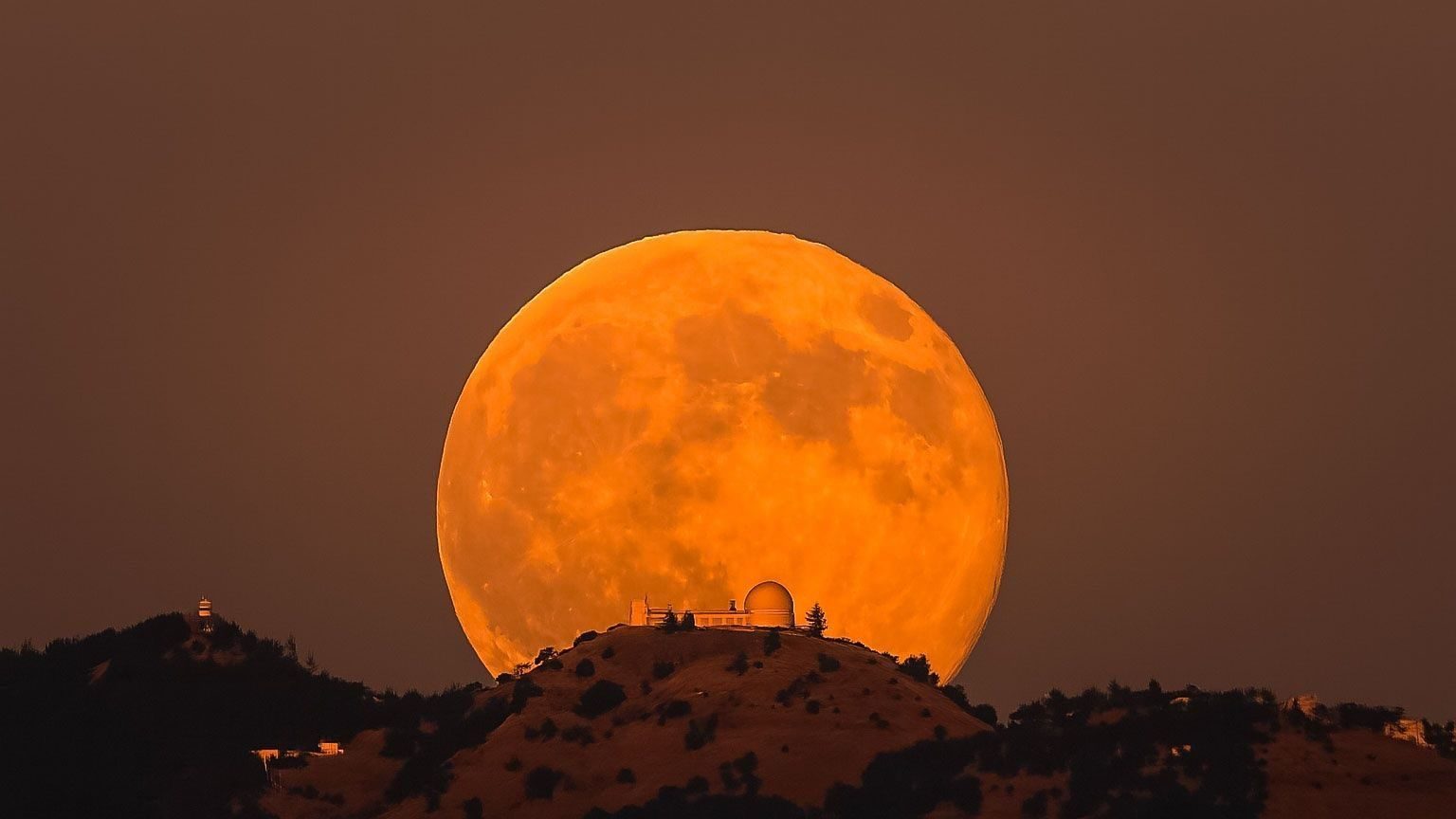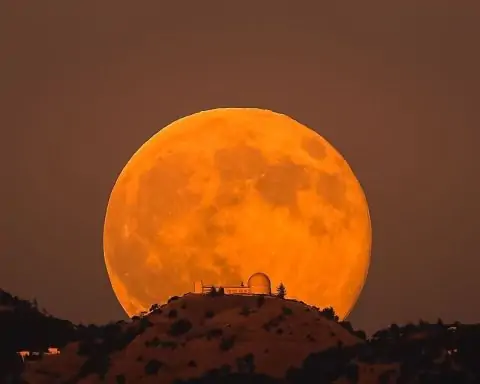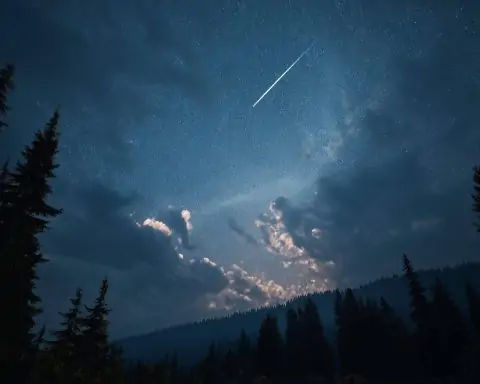The December 2025 full moon will be a bright Cold Moon supermoon on December 4, 2025 — the last full moon and final supermoon of the year. Here’s the exact time, why it’s special, and how to see it.
Key facts at a glance
- Full Moon date: Thursday, 4 December 2025 (Friday 5 December in parts of Asia/Oceania). [1]
- Exact moment of fullness: around 23:14 UTC — about 6:14 p.m. EST / 3:14 p.m. PST / 11:14 p.m. UK time. [2]
- Traditional name: Cold Moon, also known as the Long Nights Moon. [3]
- Type: Supermoon — the Moon is near its closest point to Earth, appearing a little bigger and brighter than average. [4]
- Astrology: A Full Moon in Gemini at about 13°, according to current astrological forecasts. [5]
- Bonus sky show: The Geminid meteor shower peaks a week later, on 13–14 December 2025, under relatively dark skies. [6]
When is the December 2025 full moon?
Astronomers agree that the final full moon of 2025 reaches its exact phase on Thursday, 4 December 2025, at about 23:14 Coordinated Universal Time (UTC).
- North America:
- Eastern Time (EST): around 6:14 p.m.
- Central Time (CST): around 5:14 p.m.
- Pacific Time (PST): around 3:14 p.m. [7]
- UK & Western Europe:
- UK: 11:14 p.m. GMT on 4 December. [8]
- Asia & Oceania:
- In India, much of Southeast Asia, China and Australia, the Moon is technically “full” in the early hours of Friday 5 December, which is why some calendars list the full moon on 5 December for those regions. [9]
The Moon will look full for at least a day either side of this moment, so if clouds get in the way on the 4th, you’ll still have a good show the night before and after.
Why December’s Cold Moon is a big deal: supermoon + “extreme” full moon
This is not just any full moon — December 2025’s Cold Moon is a supermoon and the final full supermoon of 2025. [10]
Recent astronomy coverage and skywatching guides highlight several reasons this one stands out:
- Last supermoon of the year, and of the current run
- October, November and December 2025 all bring full supermoons; December’s Cold Moon is the third and last of the 2025 trio, with the sequence continuing into another supermoon in January 2026. [11]
- “Extreme” supermoon status
- Some astronomers and astronomy apps describe the December Cold Moon as the last “extreme” full moon until 2042, because it occurs unusually close to the Moon’s perigee (closest approach to Earth) during an already favorable cycle. [12]
- Brighter and slightly larger than average
- NASA and other experts note that a supermoon can appear up to 14% larger and around 30% brighterthan the faintest, farthest full moon of the year. [13]
- The difference is subtle if you just glance up, but it becomes obvious when comparing photos of the December supermoon with images taken at a “micromoon” (a full moon at its farthest distance). [14]
In newsrooms from local US papers to national outlets, the December 4 Cold Moon is already being billed as a “dazzling” final supermoon of the year and a fitting finale to 2025’s busy lunar calendar. [15]
What is the “Cold Moon”? Names, folklore and long nights
The December full moon is widely known as the Cold Moon, a name rooted in long-standing seasonal traditions in North America and Europe. [16]
Common traditional names include:
- Cold Moon – for the onset of winter cold in the Northern Hemisphere.
- Long Nights Moon – because it occurs near the longest nights of the year, around the December solstice. [17]
- Moon Before Yule or Frost Moon – older European and colonial names tied to winter festivals and frosty weather. [18]
These names are not scientific, but they add cultural flavor that helps people remember the rhythm of the lunar year.
How to see the December 2025 full moon from your region
You don’t need a telescope or special equipment to enjoy the Cold Moon supermoon — clear skies and a good view of the horizon are enough. [19]
General timing
- Moonrise on 4 December will be around local sunset.
- The Moon will be highest around local midnight, and set near sunrise. [20]
Check a local almanac or weather app for exact rise/set times in your city: they vary slightly by latitude and longitude.
Best viewing tips
- Face east at sunset to catch the supermoon as it rises, when the “moon illusion” makes it look especially large near the horizon. [21]
- Choose an open spot with minimal light pollution — a park, hilltop, beach, or rural area if possible. [22]
- If you’re in a city, frame the Moon with buildings, bridges or landmarks for a dramatic view (and better photos). [23]
- Dress warmly in northern latitudes: “Cold Moon” is often an accurate description of the temperature.
North America
For much of the US and Canada, the Moon rises while it is already very close to full, and reaches exact fullness early in the evening or late afternoon depending on your time zone. That makes it an ideal family-friendly sky event: you can see it well before midnight. [24]
UK & Europe
In the UK, the full phase occurs at 11:14 p.m. GMT, placing the Moon high in a dark winter sky at convenient evening hours. Western and central Europe see similarly favorable timing around late evening local time. [25]
Asia–Pacific
Across India, Southeast Asia, China, Japan and Australia, exact fullness falls in the early pre-dawn of Friday, 5 December, but the Moon will look completely full for the entire night of the 4th. Some regional lunar calendars list the full moon on the 5th for this reason. [26]
Southern Hemisphere
Remember that in the Southern Hemisphere, December is the start of summer. The Cold Moon will still be a supermoon, but it will shine in warm summer evenings rather than frigid winter nights. The viewing geometry is similar; you’ll simply see the Moon higher or lower in the sky depending on your latitude.
Linked to a rare lunar cycle: the “major lunar standstill”
Astronomers note that the years 2024–2025 fall within a rare cycle called a major lunar standstill, which repeats about every 18.6 years. During this period, the Moon’s rising and setting points along the horizon reach their most extreme north–south limits. [27]
Coverage of the December 2024 full moon highlighted that this standstill makes moonrises and moonsets noticeably more extreme, and those effects continue into 2025. [28]
By December 2025, the standstill is easing, but you may still notice the Cold Moon tracking unusually high or low in the sky compared with where you remember it a decade or so ago — especially if you live at higher latitudes.
Supermoon science: how much bigger and brighter will it be?
The term “supermoon” isn’t an official scientific classification; astronomers often call it a “perigee full moon” — a full moon that happens close to the Moon’s perigee. [29]
Key science points:
- The Moon’s orbit is elliptical, so its distance from Earth varies by about 50,000 km (31,000 miles) over a month. [30]
- When a full moon coincides with perigee, we get a supermoon that can appear up to 14% larger and around 30% brighter than the smallest full moon (at apogee). [31]
- December’s Cold Moon is part of a cluster of three full supermoons (October–December 2025), with November’s being the closest of the year and December’s still very near perigee. [32]
To the naked eye, the size difference is modest, and many people wouldn’t notice it without a “before and after” comparison. What you will notice is the crisp brightness of this full Moon, especially when it’s high in a dark winter sky.
Will the December 2025 supermoon affect tides or weather?
Because the Moon is closer than usual, December’s supermoon will coincide with higher-than-average tides, known as perigean spring tides or “king tides.” [33]
- These tides are only a little higher than typical full-moon spring tides — often just a few centimeters (around 2 inches) above normal. [34]
- They can slightly increase coastal flood risk in low-lying areas, especially where king tides already cause nuisance flooding. Recent coverage of the October and November 2025 supermoons has highlighted localized flooding in parts of the US, for example. [35]
There is no scientific evidence that supermoons trigger earthquakes, volcanic eruptions or extreme storms, despite recurring social media myths. [36]
For coastal communities, local tide forecasts and flood advisories are more important than the “supermoon” label itself.
December 2025 night-sky bonus: the Geminid meteor shower
The show doesn’t end with the full moon. December is also home to the Geminid meteor shower, often considered the best meteor shower of the year. [37]
In 2025:
- The Geminids peak on the night of 13–14 December, about a week after the Cold Moon. [38]
- The Moon will be in a waning crescent phase, roughly 30–40% illuminated, rising in the early morning hours — much less disruptive than a full moon. [39]
- Under dark skies, observers can potentially see 100–150 meteors per hour at the peak. [40]
That means the December 4 supermoon won’t spoil the Geminids this year: by the time the meteors peak, the Moon will be smaller and dimmer, and you’ll have good conditions for both events if the weather cooperates.
Astrology & spiritual themes: Full Moon in Gemini
While astronomy focuses on orbits and physics, astrology reads full moons symbolically. Astrologers describe the December 2025 Cold Moon as a Full Moon in Gemini at about 13° of the sign, opposite the Sun in Sagittarius. [41]
Common themes in current astrological commentary (which is not scientific, but popular in lifestyle and wellness media) include:
- Communication & stories: Gemini is associated with speech, writing and information — astrologers frame this full moon as a time to review the stories you’ve told about the year and decide which ones to keep or rewrite. [42]
- Mental clarity vs. overload: It’s seen as a moment to clear mental clutter, step back from doomscrolling, and prioritize meaningful connections over noise. [43]
- Closing the year’s loops: As the last full moon of 2025, many spiritual writers suggest using it as a symbolic “completion point”: finishing conversations, wrapping projects and journaling insights from the year. [44]
If you enjoy rituals, you might:
- Spend a few minutes journaling under the full moon about what you’re ready to release.
- Have a device-free walk or conversation by moonlight to mark the end of the year.
Just remember: these interpretations are cultural and personal, not predictions backed by astronomy.
How to photograph the December 2025 Cold Moon supermoon
Expect social media to fill with Cold Moon shots — and you can absolutely add your own, even with just a smartphone.
NASA’s lunar photography guides suggest a few simple tricks: [45]
- Turn off the flash
- Your phone’s flash will only light up nearby objects and can wash out the scene. Let the Moon be the light source.
- Tap to focus on the Moon and lower the exposure
- On most phones you can tap the Moon on-screen and slide the exposure down so it looks gray with visible details, not a glowing white blob.
- Use a tripod or steady surface + timer
- Propping your phone on a wall or railing and using a 3–10 second timer helps avoid blur in low light.
- Shoot at moonrise or moonset
- When the Moon is low, it’s easier to include foreground objects (trees, skylines, mountains), which makes the image far more dramatic than a tiny Moon in a black sky. [46]
- Consider manual or “pro” mode
- If your camera app allows it, try a low ISO (50–100) and a fast shutter (around 1/125s) to prevent overexposure, then experiment from there. [47]
No fancy gear is required — but if you do have binoculars or a small telescope, holding your phone camera carefully up to the eyepiece can capture surprisingly detailed close-ups. [48]
How to make the most of the December 2025 full moon
To recap, here’s how to get the best out of December’s Cold Moon supermoon:
- Mark your calendar:
- 4 December 2025 (evening in the Americas and Europe; early 5 December in much of Asia and Oceania). [49]
- Plan a viewing spot:
- An unobstructed eastern horizon at sunset or a dark location for midnight viewing. [50]
- Watch the tides if you live on the coast:
- Expect slightly higher high tides around the full moon, especially in low-lying coastal areas. [51]
- Pair it with other sky shows:
- Come back out for the Geminid meteor shower on the nights of 13–14 December when the Moon is smaller and dimmer. [52]
Whether you’re an avid skywatcher, a photographer, or just someone who likes an excuse to look up, the December 2025 Cold Moon is set to be one of the year’s most photogenic and widely watched lunar moments — and a bright, fitting full-stop at the end of 2025.
References
1. www.timeanddate.com, 2. www.timeanddate.com, 3. www.timeanddate.com, 4. www.astronomy.com, 5. www.crystals.com, 6. www.amsmeteors.org, 7. www.timeanddate.com, 8. www.rmg.co.uk, 9. www.spaceweatherlive.com, 10. www.astronomy.com, 11. earthsky.org, 12. starwalk.space, 13. apnews.com, 14. www.timeanddate.com, 15. www.beaconjournal.com, 16. www.timeanddate.com, 17. www.timeanddate.com, 18. www.timeanddate.com, 19. apnews.com, 20. svs.gsfc.nasa.gov, 21. svs.gsfc.nasa.gov, 22. apnews.com, 23. science.nasa.gov, 24. www.timeanddate.com, 25. www.rmg.co.uk, 26. www.calendarr.com, 27. www.chron.com, 28. www.chron.com, 29. en.wikipedia.org, 30. en.wikipedia.org, 31. apnews.com, 32. earthsky.org, 33. oceanservice.noaa.gov, 34. en.wikipedia.org, 35. www.sfgate.com, 36. scienceline.org, 37. www.amsmeteors.org, 38. www.amsmeteors.org, 39. www.amsmeteors.org, 40. www.timeanddate.com, 41. www.crystals.com, 42. www.crystals.com, 43. www.crystals.com, 44. www.crystals.com, 45. science.nasa.gov, 46. science.nasa.gov, 47. medium.com, 48. orrery-media.s3.amazonaws.com, 49. www.timeanddate.com, 50. svs.gsfc.nasa.gov, 51. oceanservice.noaa.gov, 52. www.amsmeteors.org










